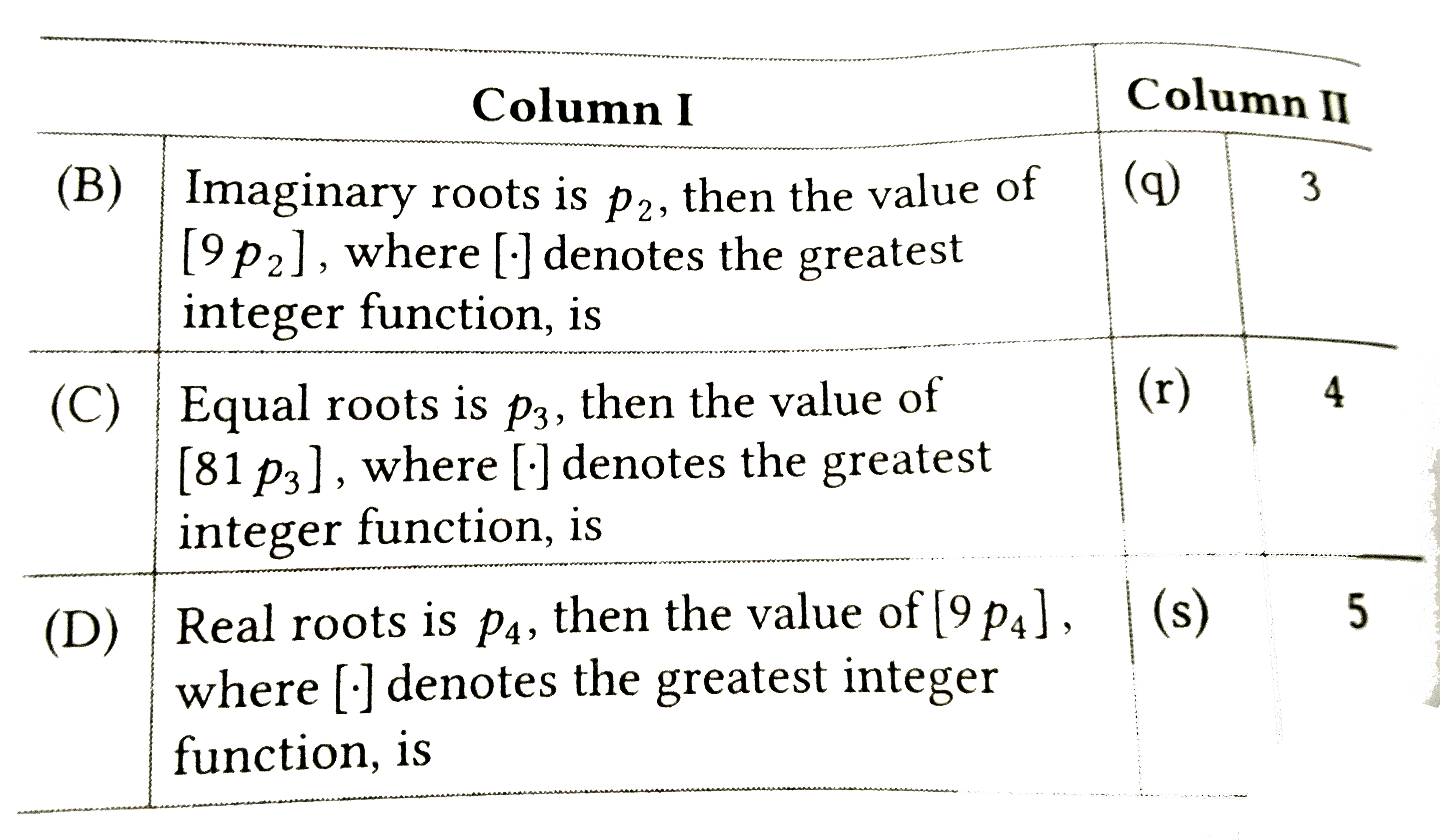If pandq are chosen randomly from the set {1,2,3,4,5,6,7,8,9,10} with replacement, determine the probability that the roots of the equation x2+px+q=0 are real.
To determine the probability that the roots of the equation x2+px+q=0 are real, we need to analyze the discriminant of the quadratic equation. The discriminant D is given by:
D=p2−4q
For the roots to be real, the discriminant must be greater than or equal to zero:
D≥0⟹p2−4q≥0⟹p2≥4q
Step 1: Identify the total number of pairs (p,q)
Since p and q are chosen randomly from the set {1,2,3,4,5,6,7,8,9,10} with replacement, the total number of possible pairs (p,q) is:
10×10=100
Hint: Count the total combinations of two variables chosen from a set.
Step 2: Count the pairs where the roots are not real
We need to find the pairs (p,q) such that p2<4q. We will evaluate this for each possible value of q from 1 to 10.
- For q=1:
p2<4⟹p<2⟹p=1(1 pair)
- For q=2:
p2<8⟹p<3⟹p=1,2(2 pairs)
- For q=3:
p2<12⟹p<4⟹p=1,2,3(3 pairs)
- For q=4:
p2<16⟹p<4⟹p=1,2,3,4(4 pairs)
- For q=5:
p2<20⟹p<5⟹p=1,2,3,4(4 pairs)
- For q=6:
p2<24⟹p<5⟹p=1,2,3,4,5(5 pairs)
- For q=7:
p2<28⟹p<6⟹p=1,2,3,4,5(5 pairs)
- For q=8:
p2<32⟹p<6⟹p=1,2,3,4,5(5 pairs)
- For q=9:
p2<36⟹p<6⟹p=1,2,3,4,5(5 pairs)
- For q=10:
p2<40⟹p<7⟹p=1,2,3,4,5,6(6 pairs)
Step 3: Calculate the total number of pairs where roots are not real
Now, we sum the number of pairs for each value of q:
1+2+3+4+4+5+5+5+5+6=38
Step 4: Calculate the probability that the roots are not real
The probability that the roots are not real is given by the ratio of the number of unfavorable outcomes to the total outcomes:
P(not real)=38100=0.38
Step 5: Calculate the probability that the roots are real
The probability that the roots are real is:
P(real)=1−P(not real)=1−0.38=0.62
Final Answer
The probability that the roots of the equation x2+px+q=0 are real is:
0.62
---
p2<4⟹p<2⟹p=1(1 pair)
p2<8⟹p<3⟹p=1,2(2 pairs)
p2<12⟹p<4⟹p=1,2,3(3 pairs)
p2<16⟹p<4⟹p=1,2,3,4(4 pairs)
p2<20⟹p<5⟹p=1,2,3,4(4 pairs)
p2<24⟹p<5⟹p=1,2,3,4,5(5 pairs)
p2<28⟹p<6⟹p=1,2,3,4,5(5 pairs)
p2<32⟹p<6⟹p=1,2,3,4,5(5 pairs)
p2<36⟹p<6⟹p=1,2,3,4,5(5 pairs)
p2<40⟹p<7⟹p=1,2,3,4,5,6(6 pairs)
Similar Questions
Real roots of equation x2+5|x|+4=0 are
View SolutionTwo numbers a and b are chosen at random from the set {1,2,3,4,...,0} with replacement. The probability that the equation x2+√2(a−b)x+b=0 has


View SolutionIf a and b are chosen randomly from the set consisting of number 1, 2, 3, 4, 5, 6 with replacement. Then the probability that limx→0[(ax+bx)/2]2/x=6 is
View SolutionFor a<0, determine all real roots of the equation x2−2a|x−a|−3a2=0.
View SolutionIf a and b are randomly chosen from the set {1,2,3,4,5,6,7,8,9}, then the probability that the expression ax4+bx3+(a+1)x2+bx+1 has positive values for all real values of x is
View SolutionIf p,q are real p≠q, then show that the roots of the equation (p−q)x2+5(p+q)x−2(p−q)=0 are real and unequal.
View SolutionFor a a≤0, determine all real roots of the equation x2−2a|x−a|−3a2=0.
View SolutionIf p,q are real p≠q, then show that the roots of the equation (p−q)x2+5(p+q)x−2(p−q)=0 are real and unequal.
View SolutionIf an integer p is chosen at random in the interval 0≤p≤5, then the probality that the roots of the equation x2+px+p4+12=0 are real is -
View SolutionTwo integers xandy are chosen with replacement out of the set {0,1,,2,3,10}. Then find the probability that |x−y|>5.
View Solution
